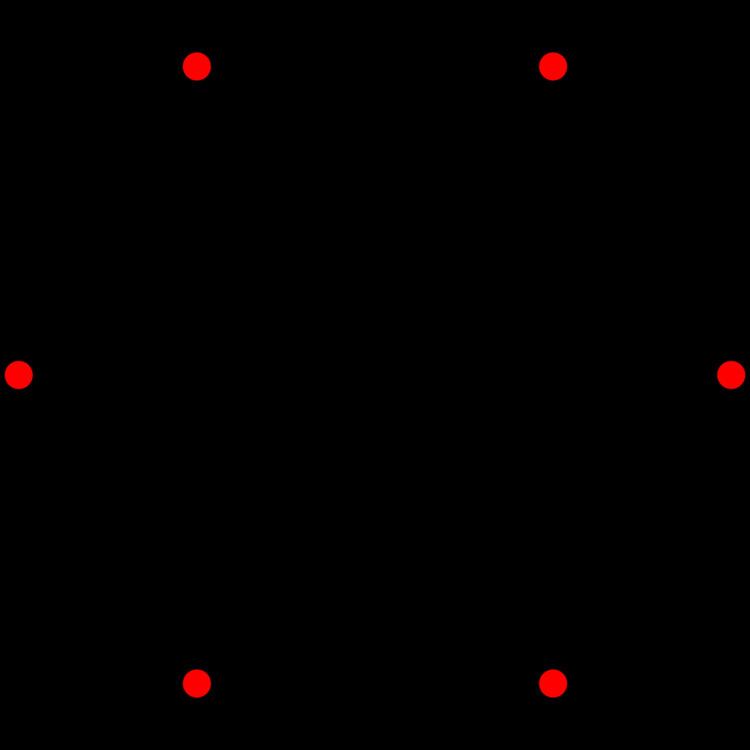 | ||
In five-dimensional geometry, a stericated 5-simplex is a convex uniform 5-polytope with fourth-order truncations (sterication) of the regular 5-simplex.
Contents
- Stericated 5 simplex
- Alternate names
- Cross sections
- Coordinates
- Root system
- Omnitruncated 5 simplex
- Permutohedron
- Related honeycomb
- Related uniform polytopes
- References
There are six unique sterications of the 5-simplex, including permutations of truncations, cantellations, and runcinations. The simplest stericated 5-simplex is also called an expanded 5-simplex, with the first and last nodes ringed, for being constructible by an expansion operation applied to the regular 5-simplex. The highest form, the steriruncicantitruncated 5-simplex is more simply called an omnitruncated 5-simplex with all of the nodes ringed.
Stericated 5-simplex
A stericated 5-simplex can be constructed by an expansion operation applied to the regular 5-simplex, and thus is also sometimes called an expanded 5-simplex. It has 30 vertices, 120 edges, 210 faces (120 triangles and 90 squares), 180 cells (60 tetrahedra and 120 triangular prisms) and 62 4-faces (12 5-cells, 30 tetrahedral prisms and 20 3-3 duoprisms).
Alternate names
Cross-sections
The maximal cross-section of the stericated hexateron with a 4-dimensional hyperplane is a runcinated 5-cell. This cross-section divides the stericated hexateron into two pentachoral hypercupolas consisting of 6 5-cells, 15 tetrahedral prisms and 10 3-3 duoprisms each.
Coordinates
The vertices of the stericated 5-simplex can be constructed on a hyperplane in 6-space as permutations of (0,1,1,1,1,2). This represents the positive orthant facet of the stericated 6-orthoplex.
A second construction in 6-space, from the center of a rectified 6-orthoplex is given by coordinate permutations of:
(1,-1,0,0,0,0)The Cartesian coordinates in 5-space for the normalized vertices of an origin-centered stericated hexateron are:
Root system
Its 30 vertices represent the root vectors of the simple Lie group A5. It is also the vertex figure of the 5-simplex honeycomb.
Alternate names
Coordinates
The coordinates can be made in 6-space, as 180 permutations of:
(0,1,1,1,2,3)This construction exists as one of 64 orthant facets of the steritruncated 6-orthoplex.
Alternate names
Coordinates
The coordinates can be made in 6-space, as permutations of:
(0,1,1,2,2,3)This construction exists as one of 64 orthant facets of the stericantellated 6-orthoplex.
Alternate names
Coordinates
The coordinates can be made in 6-space, as 360 permutations of:
(0,1,1,2,3,4)This construction exists as one of 64 orthant facets of the stericantitruncated 6-orthoplex.
Alternate names
Coordinates
The coordinates can be made in 6-space, as 360 permutations of:
(0,1,2,2,3,4)This construction exists as one of 64 orthant facets of the steriruncitruncated 6-orthoplex.
Omnitruncated 5-simplex
The omnitruncated 5-simplex has 720 vertices, 1800 edges, 1560 faces (480 hexagons and 1080 squares), 540 cells (360 truncated octahedrons, 90 cubes, and 90 hexagonal prisms), and 62 4-faces (12 omnitruncated 5-cells, 30 truncated octahedral prisms, and 20 6-6 duoprisms).
Alternate names
Coordinates
The vertices of the truncated 5-simplex can be most simply constructed on a hyperplane in 6-space as permutations of (0,1,2,3,4,5). These coordinates come from the positive orthant facet of the steriruncicantitruncated 6-orthoplex, t0,1,2,3,4{34,4}, .
Permutohedron
The omnitruncated 5-simplex is the permutohedron of order 6. It is also a zonotope, the Minkowski sum of six line segments parallel to the six lines through the origin and the six vertices of the 5-simplex.
Related honeycomb
The omnitruncated 5-simplex honeycomb is constructed by omnitruncated 5-simplex facets with 3 facets around each ridge. It has Coxeter-Dynkin diagram of .
Related uniform polytopes
These polytopes are a part of 19 uniform 5-polytopes based on the [3,3,3,3] Coxeter group, all shown here in A5 Coxeter plane orthographic projections. (Vertices are colored by projection overlap order, red, orange, yellow, green, cyan, blue, purple having progressively more vertices)
